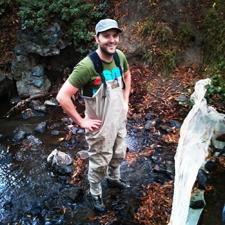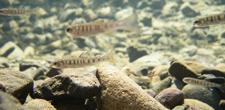Fish habitat response to streamflow augmentation
Summary:
Declining water levels can degrade or eliminate fish habitat during California’s dry summer season, particularly as water is diverted for other needs. Storing water off-channel during the rainy season can help reduce demands on instream flows in the dry season. In northern California, landowners have also begun to release stored water back into streams to protect endangered salmon during critical low-flow periods. This study was designed to gain a better understanding of the relationship between streamflow and fish habitat conditions, taking advantage of a novel streamflow augmentation project on Porter Creek in Sonoma County, California. The results are informing the flow-release schedule at Porter Creek; aid in the prioritization, design, and evaluation of other streamflow enhancement projects; and guide regional flow recommendations.
Investigator:
Theodore Grantham
Assistant Cooperative Extension Specialist
Department of Environmental Science, Policy, and Management
University of California, Berkeley
Project description:
In Mediterranean-climate regions such as California, declining water availability during the dry season can greatly reduce the amount of habitat available for fish, leading to population declines and possible extirpation. Water withdrawals can intensify the effects of seasonal drought, particularly when the timing of diversion coincides with periods of naturally low-flow. On the north coast of California, surface water diversions for vineyard agriculture and other human uses are depleting flows in rivers and streams that support endangered coho salmon (Oncorhynchus kisutch) and threatened steelhead trout (O. mykiss).
A promising approach to preventing flow-related impacts to salmon has been to expand capacity of off-stream storage; tanks or reservoirs can be filled in the wet season, when water is abundant, and used for irrigation and other needs in dry season, when water would otherwise be directly diverted from streams. Recently, some private landowners have voluntarily offered to release clean, cold water from storage facilities back into streams to improve salmon rearing habitat and prevent fish mortality during the dry season. These innovative flow augmentation projects reflect a growing interest by landowners to dedicate a portion their water right back to the environment; however, they are looking for assurances that dedicated water achieves desired ecological outcomes, as well as guidance as to the appropriate timing, volume, and duration of flows to release each year.
This study was designed to help evaluate the ecological benefits of a streamflow augmentation project, in which stored water was released into a stream to protect endangered salmon during the low-flow summer season. We quantified how artificially increased flows affect the quantity and quality of fish habitat on Porter Creek, a tributary to the Russian River in Sonoma County, California. We specifically assessed how flow releases affected the hydrologic connectivity, spatial distribution, quality, and total availability of salmon rearing habitat. We also quantified how effects of flow augmentation changed over the course of the dry season, when water inputs from ambient sources naturally declined. We used repeated habitat surveys, coupled with continuous monitoring of surface water flow and water quality parameters, to quantify fish habitat responses to flow enhancement.
The study results are directly informing operations of the flow augmentation project on Porter Creek. By providing resource agencies and key stakeholders with critical information about the relationships between streamflow and fish habitat, the study also aided in the prioritization, design, and evaluation of other flow enhancement projects, inform regional instream flow recommendations, and support planning for emergency drought actions, such as fish relocations.


